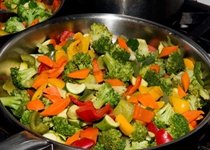 We are all creatures of habit. Once we get into a particular routine, it is difficult to change. You get up at the same time every morning, you take the same route to work, and you arrive at the same time, most of the time. You likely even consume the same foods every day—and eat them the same way.
We are all creatures of habit. Once we get into a particular routine, it is difficult to change. You get up at the same time every morning, you take the same route to work, and you arrive at the same time, most of the time. You likely even consume the same foods every day—and eat them the same way.
Unfortunately, your daily eating habits, even if you are eating healthy foods, may actually be your downfall. You eat healthy foods because they are good for you, right? Well, just because your favorite healthy foods contain an abundance of nutrients doesn’t necessarily mean you will obtain them. That depends on several factors.
How do you cook your healthy foods? Are you eating them at the appropriate time? Let me tell you the way that I eat a few healthy foods that will help you obtain every nutrient for a healthier and fulfilling life.
1. Broccoli
Broccoli is one of my favorite foods. I enjoy eating it as a side, or blending it into a soup. It is also one of the better foods for your body. It is loaded with vitamins A, C, and K, as well as folate and fiber! It also has carotenoids, polyphenols, quercetin, glucosinolates, and kaempferol. It is among the healthy foods that help fight cancer and lower your risk of heart disease. It also helps promote bone and vision health. But you can’t realize all of these benefits unless you cook it the right way.
Steaming is the best cooking method for preserving and increasing the nutrient content of broccoli, according to a study published in the Journal of Agriculture and Food Chemistry. Other cooking methods, such as frying, destroy important nutrients and can even create harmful volatile compounds. And while you may just eat the broccoli florets, you might want to think about including the rest of the broccoli. The broccoli stems actually contain more fiber, while the leaves contain greater beta-carotene content.
2. Tea
A common daily habit in many cultures is drinking a cup of tea. Some people drink tea for pleasure; however, traditional Chinese medicine praises tea for its ability to prevent and fight many diseases. Green tea is very popular for its cancer-fighting antioxidant catechins—epigallocatechin-3-gallate (EGCG). In Britain, it is a custom to drink tea with milk and sugar. However, if you plan on absorbing the beneficial nutrients of tea, this method is a bad idea.
The consumption of any dietary protein, such as cow’s milk (casein protein) or soymilk, will reduce the bioavailability of the catechins in green tea, according to a randomized crossover study published in the European Journal of Nutrition. The study observed 24 healthy women. They consumed 1.75 grams of green tea with soymilk, milk, or skimmed milk. Also, adding lemon may also increase the bioavailability of nutrients in green tea. So the best way to drink tea is to drink it clear.
3. Carrots
Carrots are full of vitamin A and carotenoids, such as beta-carotene. Carrot and ginger soup is one of my favorites; however, some research from Newcastle University led me to discover that I’ve been making it wrong. What’s the problem? The study found that cutting carrots reduces their nutrients.
So what’s the best way to cook carrots to get the most nutrients? It is best to wash and peel your carrots, then put them in your steamer whole. Like with most vegetables, steaming carrots provides the most flavor and maximizes the nutrient content. What about eating raw carrots? You actually enhance the bioavailability of the carotenoids in carrots when you cook them.
Why is it important to eat your healthy foods right? It is simply because there may be detrimental effects from eating your food wrong. You put yourself at risk for nutrient deficiency and malabsorption. These issues stem from a lack of stomach acid being produced, and can lead to other conditions and degenerative diseases. So just try to remember the above helpful tips for cooking your next healthy meal.
Sources for Today’s Article:
Miglio, C., et al., “Effects of different cooking methods on nutritional and physicochemical characteristics of selected vegetables,” Journal of Agriculture and Food Chemistry January 9, 2008; 56(1): 139–147.
“Why I should eat the stems and leaves of broccoli,” The World’s Healthiest Foods web site; http://www.whfoods.com/genpage.php?tname=foodtip&dbid=6, last accessed October 29, 2014.
Egert, S., et al., “Simultaneous ingestion of dietary proteins reduces the bioavailability of galloylated catechins from green tea in humans,” European Journal of Nutrition February 2013; 52(1): 281–288, doi: 10.1007/s00394-012-0330-8.
Link, L.B., et al., “Raw versus Cooked Vegetables and Cancer Risk,” Cancer Epidemiology, Biomarkers & Prevention September 2004; 13: 1422.
Barbour, S., “Cancer boost from whole carrots,” BBC News web site, June 16, 2009; http://news.bbc.co.uk/2/hi/health/8101403.stm.
Purdue University, “Citrus Juice, Vitamin C Give Staying Power To Green Tea Antioxidants,” ScienceDaily web site, November 14, 2007; http://www.sciencedaily.com/releases/2007/11/071113163016.htm.
